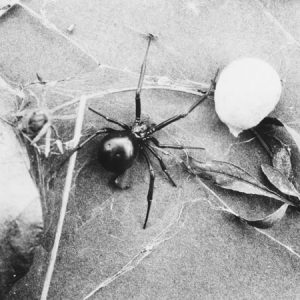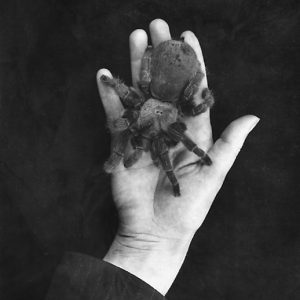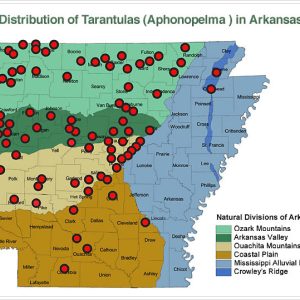calsfoundation@cals.org
William J. Baerg (1885–1980)
William J. Baerg was a naturalist, entomologist, and teacher who served as head of the Department of Entomology at the University of Arkansas (UA) in Fayetteville (Washington County) for thirty-one years. His research on black widow spiders, tarantulas, scorpions, and other arthropods led to descriptions of their behavior, biology, and natural history that had previously been largely ignored by biologists and entomologists.
William Baerg was born in Hillsboro, Kansas, to Johann and Magaretha (Hildebrand) Baerg on September 24, 1885. His parents, who had left Russia in 1874, worked as field hands on a Kansas wheat farm. The family later acquired a small piece of land for their own. Baerg was the sixth of seven children.
Baerg began school at age seven. At fourteen, he left school to help his father on the farm. His father, a stern and pious man, was a strict disciplinarian.
After attending preparatory school to complete his primary education, Baerg took classes at Tabor College in Hillsboro beginning in 1908 and spent summers working in the wheat fields. He graduated in 1911 and entered the University of Kansas, where, in 1913, he began studying grasshoppers for the entomology department. After graduating in 1915, Baerg enrolled for classes at Cornell University in Ithaca, New York, to pursue entomology, but he left Ithaca in 1918 before completing his Ph.D. to take a job at the University of Arkansas in Fayetteville as the head of the entomology department.
Baerg was introduced to his first tarantula at the university, marking the start of a life-long affection for these arachnids. Baerg also started teaching an introductory entomology course during his first year.
Baerg’s first publication, titled Beekeeping in Arkansas, was published in 1920.This was followed by another bulletin, published in 1921, called Spraying for the San Jose Scale. He published as William J. Baerg, though he adopted the initial “J” himself, as his parents did not give him a middle name.
Baerg considered obtaining his Ph.D. at Cornell. After arranging for a temporary replacement as department head, Baerg returned to Ithaca in 1921 for one year to work on his doctoral thesis. Baerg’s work included research with strawberry insects, but his fascination with tarantulas continued. Baerg completed his Ph.D. in entomology in 1922 and returned to Fayetteville.
Baerg was challenged by a Cornell colleague to investigate whether black widows were harmless or poisonous, and he set out to answer this question. He made extensive observations of black widow behavior and its venom’s effects on rats. Baerg used himself as an experimental subject to test the effects of the venom on humans. He induced a black widow to bite the third finger of his left hand, but the bite was apparently superficial, and he suffered no symptoms besides a “slight, sharp pain.” Baerg repeated the test the following day, this time allowing the spider’s fangs to remain inserted for five seconds. During the next three days, Baerg recorded his symptoms and reactions, creating the first account of the effects of the black widow spider bite on humans; it was published in the March 1923 edition of The Journal of Parasitology (vol. 9, no. 3). Baerg observed the swelling and pain that followed the spider’s bite, noting that, as the symptoms spread to his shoulder, chest, and hips, he had problems with breathing and speech. He also noted that the “doctor advises that I go to bed.” He recalled the experience later, saying that the pain was severe and different from anything he had ever experienced. Baerg induced numbers of arachnids to bite or sting him over the successive years and recorded the resulting effects. Baerg made numerous trips to Panama and Mexico to study tarantulas, scorpions, and other arachnids. He published a small book, The Tarantula, in 1958.
Baerg’s love of nature went beyond entomology and spiders. Five years spent studying bird songs and observing seasonal changes in their populations culminated in a 1931 publication titled Birds of Arkansas. A revised edition was printed in 1951.
Baerg met Eloise Farris during the Depression. They were married on July 27, 1931, and had two children, Gretchen and William.
Baerg retired in 1951, having served as head of the UA Department of Entomology for thirty-one years. Baerg’s scholarly pursuits continued after retirement. He traveled to Jamaica in 1951 and 1952 as a Fulbright Scholar and was in Mexico as a Guggenheim Fellow in 1954 and 1955. At the age of eighty-five, Baerg volunteered to be the experimental animal to test the effects of the venom of the yellow sac spider. The director of that research project declined Baerg’s offer.
Throughout his career, Baerg published a number of small books and seventy-five scientific papers, and he had collected many others. Baerg died in Fayetteville on April 14, 1980. He was cremated and his ashes spread under the holly tree in the backyard of the family home in Fayetteville.
For additional information:
“Dr. William J. Baerg: Entomologist Extraordinary.” Flashback 34 (May 1984): 1–18.
Peck, William B. “J. Baerg, 1885–1980.” Journal of Arachnology 9, no. 1 (1981): 115–116.
William J. Baerg Collection. Special Collections. University of Arkansas Libraries, Fayetteville, Arkansas. Finding aid online at https://uark.as.atlas-sys.com/repositories/2/resources/194 (accessed September 28, 2023).
Eddie Dry
Arkansas State University–Mountain Home
This entry, originally published in Arkansas Biography: A Collection of Notable Lives, appears in the CALS Encyclopedia of Arkansas in an altered form. Arkansas Biography is available from the University of Arkansas Press.
 Early Twentieth Century, 1901 through 1940
Early Twentieth Century, 1901 through 1940 Education, Higher
Education, Higher Science and Technology
Science and Technology Applied Entomology by William Baerg
Applied Entomology by William Baerg  Black Widow Spider
Black Widow Spider  Tarantula
Tarantula  Tarantula Distribution
Tarantula Distribution 




Many years ago, I was at the Los Angeles natural history museum. Members were allowed to go back where the spiders and other things were kept. Seeing a tarantula, I mentioned that my uncle, Bill Baerg, studied spiders, especially tarantulas and black widows. I was then told that Baergs book was used until an updated version came out. That made me feel pretty good.